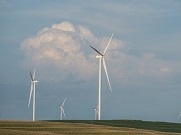Endesa will invest around 256 million euros in the construction of these three wind farms and employ around 350 people from the local area, in keeping with the Shared Value Creation plan that the company's renewable energy subsidiary, EGPE, applies in the construction of all its plants.
Campillo I will have an installed capacity of about 76.8 MW, while Campillo II and III will have a capacity of 91.2 MW each. The three facilities will produce approximately 660 GWh per year, which is more than double the annual consumption of a city like Cuenca.
To undertake this project, which will also have four electrical substations and three high-voltage lines, Endesa has been in continuous dialogue with the main local representatives and the competent authorities, in order to reach agreement on how the works will be carried out while minimizing the environmental impact and maximizing the social impact.
This is one of Endesa's priorities when it comes to developing its renewable capacity in accordance with the stated goal announced in November of achieving zero emissions by 2040. The construction of all renewable projects is based on Enel Green Power's "Sustainable Construction Site" model, including the installation of photovoltaic solar panels to meet part of the energy needs during the construction work and water-saving measures through the installation of tanks and rainwater collection systems. In addition, a charging point for electric vehicles and defibrillators will be installed. Once the work is complete, some of the equipment will be donated to the local authority for public use.
In addition, the Campillo wind farms are trailblazers in terms of the execution of the project since an "Alliance" has been signed with the companies responsible for the works. This Alliance promotes communication and collaboration between the different contractors and EGPE, seeking to leverage synergies and share ideas and experiences. The aims of this collaboration are to improve health and safety, reduce risks as well as extra costs and even accelerate the execution of the project.
Once the construction of these plants is complete, part of their output will be supplied to the international healthcare company Johnson & Johnson, with whom Endesa signed a Virtual Power Purchase Agreement (VPPA) last July. The energy supply foreseen in this VPPA will combine solar and wind sources. The Campillo II and III wind farms will account for approximately 80% of the energy, with the 47 MW Veracruz photovoltaic plant in Badajoz contributing the remaining 20%. Through the agreement, the renewable energy supplied to Johnson & Johnson will avoid the annual emission of around 130,720 tons of CO2 into the atmosphere.
Endesa currently manages a renewable capacity of more than 7,779 MW in Spain through EGPE, including: 4,745 MW of hydropower; 2,422 MW of wind power, 609 MW of solar capacity, and 3 MW from other renewable sources.
Enel Green Power, within the Enel Group, develops and operates renewable energy plants worldwide and is present in Europe, the Americas, Asia, Africa and Oceania. A world leader in clean energy, with a total capacity of around 51 GW and a generation mix that includes wind, solar, geothermal, and hydroelectric power, Enel Green Power is at the forefront of integrating innovative technologies into renewable energy plants.
Endesa is the largest electricity company in Spain and the second largest in Portugal. Endesa operates an end-to-end business from generation to marketing and through Endesa X also offers value-added services aimed at the decarbonization of energy uses in homes, companies, industries and public administrations. Endesa is firmly committed to the United Nations SDGs and therefore strongly supports the development of renewable energies through Enel Green Power España, the electrification of the economy and Corporate Social Responsibility. The Endesa Foundation is also active in CSR. Our workforce numbers around 10,000 employees. Endesa is a subsidiary of Enel, Europe’s largest electricity group.


